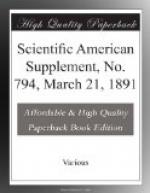One hundred and seventy-five glove makers and 20,000 people in Fulton County draw their subsistence directly from glove making. Some of the firms have a business reaching from $100,000 to $500,000 yearly. The majority, however, have small shops, and do a small but profitable business. Most of the work in Fulton County, as abroad, is done at the homes of the workers. The streets of Gloversville and Johnstown are lined with pretty and tasteful homes, in which the hum of the sewing machine is constantly heard during the working hours of the day, but the workers are exceptionally fortunate in being able while earning good wages to enjoy all the comforts and surroundings of home, and in being practically their own masters and mistresses.
Before the leather can be cut and sewed into the handsome articles that are sold over the counters of the retail dry goods houses and furnishing goods stores as gloves, the skins from which they are made must be specially prepared. The two important points in this preparation are the removal of the albuminous portion of the skin and the retention and chemical changing of the gelatinous part, so that it shall become pliable, elastic, and resist decomposition.
There are various methods which produce these results, and they are technically known as tanning, alum dressing, oil dressing, and Indian dressing. Each method produces a leather distinctly different from that produced by any other. All the preliminary processes of these various methods are alike in principle, although they vary somewhat in detail. The object in all is to remove the hair from the hide, separate the fleshy and albuminous matter, and leave only the gelatinous, which alone is susceptible to the chemical action and can be transformed by it into leather.
When the skins are received in the factory they are thoroughly soaked to open out the texture and prepare them for the removal of the hair. Then the skins are placed in vats of lime water, where, for two or three weeks, the lime works into the flesh and albuminous matter, and loosens the hair. The skins having thus been properly softened, the dirty but picturesque operation of beaming for removing the hair ensues. Before each beamer, as the workman is called, is an inclined semi-cylindrical slab of wood covered with zinc. The skin is first spread upon this, and the broad, curved beam of the knife glides across it from end to end, scraping and removing all the loosened hair, the scarf skin, and the small portion of animal matter adhering to the skin.
After the unhairing, kid skins must be fermented in a drench of bran, whose purpose is to completely decompose the remaining albuminous matter, and also to remove all traces of the lime. The operation is extremely delicate. While the gelatine is not so sensitive to the decomposing action of the ferment, nevertheless great care is required to prevent overfermentation and resulting damage to the texture of the skin.




